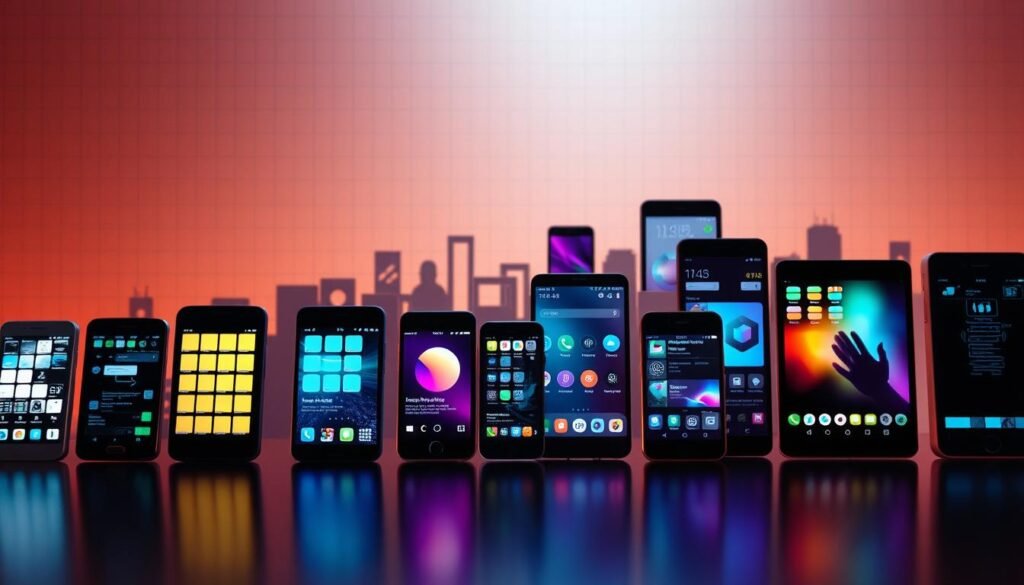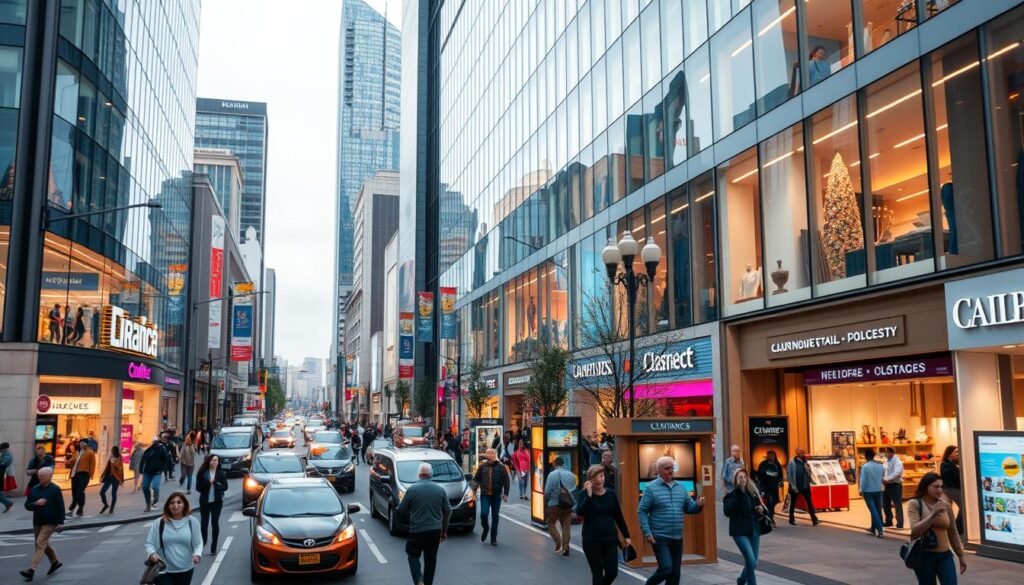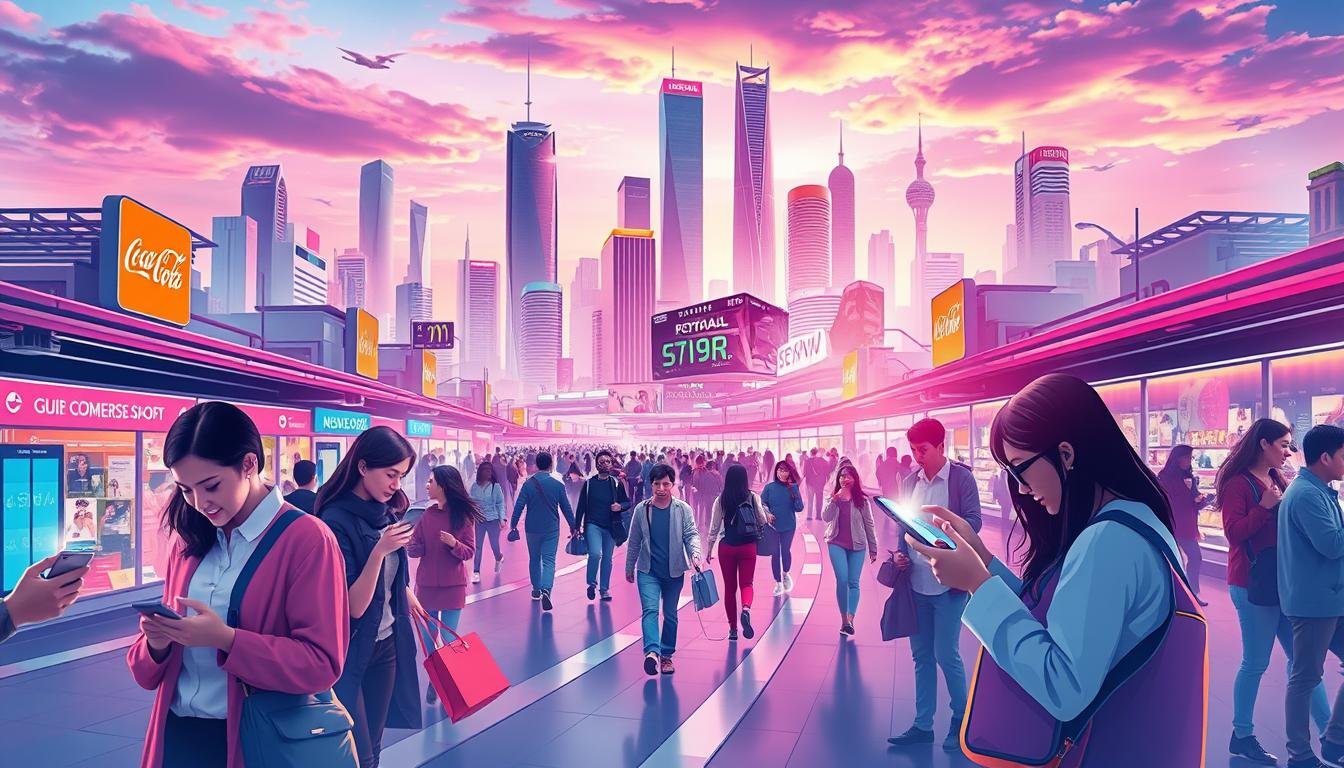By 2025, mobile commerce is expected to make up 75% of all e-commerce sales. This change is huge and happening fast. Mobile commerce stats show that global revenue will reach $6.5 trillion by 2025, beating desktop sales.
Why are people moving to mobile? 73% of shoppers prefer mobile apps over websites for their ease. Even old industries are catching up, with mobile wallets like Apple Pay and Google Pay handling 60% of digital payments. But, 70% of online shopping carts are left behind because of bad mobile checkout designs.
The move to mobile is driven by users who want quick and easy shopping. Voice search has grown 321.74% from 2021, with 22% of buyers using voice to buy. As mobile shopping grows, brands need to keep up or get left behind.
Key Takeaways
- Mobile commerce statistics show 75% of e-commerce sales will be mobile by 2025.
- Global m-commerce revenue is set to reach $6.5 trillion, driven by app preferences and mobile wallets.
- 73% of shoppers choose mobile apps over websites, signaling a permanent shift in consumer behavior.
- Legacy checkout systems face a crisis: 70% of carts are abandoned due to poor mobile design.
- Businesses without mobile-optimized experiences risk 75% lower conversion rates compared to optimized sites.
The Rise of Mobile E-Commerce: A Paradigm Shift
Smartphones have changed how we shop, making mobile shopping a top priority. The desktop to mobile transition is now essential. Old e-commerce ways face new challenges from apps, voice search, and instant buys, pushing for better mobile experiences.
From Desktop-First to Mobile-First Shopping
Before, websites were made for computers, but now they must work on phones. By 2025, 75% of online shopping will be on mobiles. Already, 50% of online traffic comes from smartphones. Brands that don’t focus on mobile risk losing 70% of customers who leave because of bad design.
The Current State of Mobile Commerce in the United States
In the U.S., mobile shopping made $339 billion in 2020 and is expected to reach $2.51 trillion by 2025. Over 79% of Americans have smartphones, and 49% use voice search to buy things. Mobile shopping now accounts for 72.9% of U.S. online sales. Here are the numbers:
| Statistic | 2023 | 2025 Projection |
|---|---|---|
| Mobile Commerce Sales (USD Trillion) | 1.5 | 2.51 |
| Mobile Traffic % | 50% | 75% |
| Mobile Payment Users | 81% | 90%+ |
Key Statistics Driving the Mobile Revolution
- 70% abandon carts for unoptimized mobile sites
- 85% prefer mobile payment options like Apple Pay
- Users expect pages to load in under 3 seconds (current average: 15 seconds)
These facts show a clear truth: mobile shopping rules today. Brands must keep up with the mobile retail revolution or they’ll fall behind in a world where mobile shopping is key.
Understanding the 75% Mobile Commerce Prediction

Behind the 75% m-commerce forecast is deep e-commerce market analysis. It tracks how people use devices and spend money. Recent shopping behavior projections show 79% of people bought something on their phones in the last six months. This shows a big change.
Market Analysis Behind the Forecast
In 2023, global m-commerce revenue was $1.71 trillion. For 2024, it’s expected to reach $2.07 trillion. Here’s how it’s growing:
| Year | Revenue (Billions) | % Growth |
|---|---|---|
| 2023 | $1.71T | 15.5% |
| 2024 | $2.07T | 21.1% |
| 2025 | $2.51T | 21.3% |
Growth Trajectories from 2023 to 2025
Mobile retail predictions point out important points:
- US smartphone users will spend 3h15m daily on devices by 2024
- Mobile app conversion rates are 157% higher than mobile web
- Shopping cart abandonment drops to 20% on apps vs 97% on websites
Industry Expert Perspectives on Mobile Dominance
“The digital commerce trends show mobile isn’t just a channel—it’s the backbone of retail,” stated an EMARKETER analyst. “Voice shopping and AR integration are accelerating this shift.”
Analysts say app engagement is rising: 85% of shoppers prefer app-first brands. With 75% of Gen Z using TikTok for purchases, brands ignoring mobile risk losing this demographic. By 2025, BNPL payments could hit $108.43B, further fueling m-commerce forecasts.
Why Consumers Prefer Shopping on Mobile Devices
Today, mobile shopping preferences are all about convenience. With 98% of Americans owning cellphones and checking them 144 times a day, phones are always by our side. This makes it easy to browse and buy on the go.
Mobile apps now convert three to four times better than mobile websites, proving smartphone shopping advantages in action.
Convenience factors like one-click ordering and app reminders make shopping easier. Shoppers love the 24/7 access and instant buys. They also appreciate personalized tips based on their past shopping.
- Always available: 49% of 18-49-year-olds use phones weekly for purchases
- Impulse-driven: 76% search products in-store to compare prices or check stock
- Personalized: 70% of U.S. adults now favor mobile-first brands
These trends show how mobile purchasing decisions fit into our busy lives. As we spend more time online, businesses need to make shopping on phones easy and smooth. The phone has become our new shopping spot.
The Evolution of Mobile Shopping Experiences

Mobile shopping has changed a lot. It’s now easy and fun, thanks to mobile UX design and responsive design. These changes make it simple to shop on small screens.
From Clunky Mobile Sites to Seamless Interfaces
Old mobile sites were hard to use. They loaded slow, had tiny buttons, and were hard to navigate. Now, mobile interface evolution makes things simple. Responsive design makes sure pages work on any device. And, important actions are easy to find.
| Early Challenges | Modern Solutions |
|---|---|
| Small buttons | Thumb-friendly zones |
| Slow performance | Optimized server loads |
| Complex menus | Intuitive navigation |
“Shopping apps have three to four times higher conversion rates than mobile websites.” – Industry Analysis 2023″
The Role of Dedicated Shopping Apps
Shopping apps are now key, with 3-4x higher conversion rates than mobile sites. Apps like Sephora’s AR try-on tools or Amazon’s one-click checkout show their worth. They offer:
- Push notifications for promotions
- Offline browsing capabilities
- Integrated mobile wallets
How UX Improvements Drive Mobile Conversion Rates
Improving mobile checkout optimization makes shopping smoother. Key strategies include:
- Progress bars showing steps remaining
- Guest checkout options
- Autofill forms for speed
These changes cut cart abandonment by 20-30%. This shows how important UX is in turning browsers into buyers.
Technologies Fueling the Mobile E-Commerce Revolution
5G networks are changing retail fast. They make augmented reality shopping possible, where you can see furniture in your home or try makeup online. Already, 32% of shoppers use AR, and 40% are willing to pay more for it.
5G retail impact also means you can get real-time updates on stock and video chats instantly. This makes online shopping feel like you’re there in person.
Mobile AI implementation helps make better choices. Algorithms suggest products based on what you browse, and chatbots are always ready to help. AI boosts sales by making each interaction personal.
Voice commerce is also growing fast. In just two years, voice-assisted sales jumped 321.7%. Now, 49% of U.S. users search for products by voice, making one-click purchases easy with tools like Amazon Alexa.
Mobile payment innovation makes buying easier. Digital wallets and biometric checks speed up checkout. For example, Starbucks’ app lets you order in seconds with mobile payments.
These technologies work together to make shopping smooth and easy. By 2025, 72% of online sales will be made on mobile. Businesses that don’t keep up will lose out as customers want fast, easy, and personalized shopping.
Social Commerce: Where Mobile Shopping Meets Social Media

Social media shopping is changing retail, with global sales expected to reach $2.9 trillion by 2026. Platforms like Instagram, TikTok, and Pinterest are turning feeds into stores.
“Social commerce is projected to grow from $570 billion in 2023 to over $1 trillion by 2028,”
Instagram Commerce is a leader, with 83% of users finding products there. It had 46.8 million buyers in 2023. Big names like Nike and Sephora show off products in Stories and posts, making it easier to buy.
TikTok’s retail influence grew with its “TikTok Made Me Buy It” trend. 35.3 million U.S. users bought things on TikTok in 2023, a huge jump from 2020. Short videos lead to quick buys, with 32% of Gen Zers buying based on influencer tips.
Pinterest product discovery excels with visual search. Over 80% of users look for inspiration on Pinterest, leading to purchases with “buyable pins.” Beauty and home brands see a 30% boost in sales through this method.
These social shopping trends show a focus on mobile. Brands need to use these platforms to reach the 110 million U.S. social buyers by 2025. With TikTok and Instagram leading, ignoring social commerce could leave businesses behind in a $100 billion+ U.S. market.
Mobile Payment Innovation: Reducing Purchase Friction
Mobile checkout optimization has changed the game for businesses looking to reduce cart abandonment. Digital wallets like Apple Pay and Google Pay now handle 60% of global digital transactions. This makes payments smoother for users. One-click purchasing removes the need to re-enter details, solving the last hurdle in mobile shopping.
“Biometric authentication and real-time encryption are making mobile payments both faster and safer than ever.”
- Biometric authentication via facial recognition or fingerprints adds layers of payment security without slowing checkout.
- Buy Now, Pay Later (BNPL) options, integrated with contactless payments, boost average order values by enabling affordable installment plans.
- White-label payment solutions help businesses balance security and user experience without heavy IT investments.
Frictionless payment systems like one-click purchasing reduce checkout steps from 5 to 1. This directly tackles the 35% of abandoned carts linked to lengthy forms. Yet, businesses must balance innovation with transparency: 43% of consumers avoid new digital wallets due to privacy concerns.
Tokenization and end-to-end encryption in payment processing now protect data better than traditional methods. This eases these fears. As global cashless transactions surge toward 2.3 trillion by 2027, prioritizing seamless payment options isn’t optional—it’s foundational for retaining customers in the mobile-first era.
How Mobile E-Commerce Is Reshaping Customer Expectations

“Speed and relevance are now non-negotiable in the mobile-first world.”
Mobile devices have made instant shopping gratification a must. Shoppers want quick order confirmations and same-day delivery. They also expect smooth app experiences.
McKinsey’s 2020 report showed a big jump in digital adoption. This means people want things fast, not cheap. Now, 40% of users use voice search daily, looking for quick answers.
| Feature | Mobile Websites | Mobile Apps |
|---|---|---|
| Conversion Rates | 20% | 157% higher |
| Cart Abandonment | 97% | 20% |
Today, same-day delivery and real-time inventory checks are must-haves. Retailers like Target use apps to show stock updates instantly. This cuts down wait times a lot.
Voice shopping is a big deal, with a $40B market in 2023. It shows how users want easy, hassle-free shopping.
Geo-targeted contextual mobile commerce uses location data for better offers. Apps send push notifications when you’re near a store or when it rains. This tech boosts location-based retail by 88%.
Mobile apps collect data for shopping experience personalization. Amazon uses over 100 data points to suggest products, making 35% of sales. Retailers track wishlists, browsing history, and in-store visits to offer personalized deals.
This approach makes customers feel understood, not just targeted.
Challenges Businesses Face in the Mobile-First Economy
Businesses face big challenges in the mobile-first economy. They struggle with making their sites work well on mobile devices. Old systems don’t fit with today’s needs, leading to expensive updates.
Small businesses find it hard to keep up. They have to compete with big names like Amazon, who have lots of money to spend.
70% of shopping carts are abandoned due to unexpected costs, mandatory account creation, or slow delivery options.
- Technical Debt: Old systems slow down mobile app development, making checkout hard.
- Multi-Device Shopping Gaps: Different experiences on phones, tablets, and desktops upset customers.
- Competitive Pressure: The app store is crowded, and competitors push for new ideas.
- Security Risks: Data breaches and following rules like GDPR add to the problem.
Small businesses have a hard time with resources. While big names like Starbucks invest in new tech, small shops have to be careful with their money. They need to make their sites fast and secure.
Fast sites are key: 84% of users leave if a site takes too long. The competitive mobile landscape means brands must focus on quick checkout and prices that match where you are. They also need to make sure users can switch devices without losing their shopping cart.
To succeed, businesses need to plan carefully. They should make their tech work better, invest in teams that can move fast, and use tools that are easy to change. The risk is high: 92% of online shoppers avoid sites that don’t work well on mobile. Those who don’t keep up will miss out on the 75% mobile commerce market by 2025.
Mobile-First Strategy: Essential Components for Success

Adapting to mobile-first development is now a must. Mobile commerce is set to reach $710.4 billion by 2025. Businesses need to focus on how users use smartphones. They should consider app vs mobile site, thumb-friendly design, and easy checkout.
Mobile Site Optimization vs. App Development
Choosing between an app or a mobile site is a big decision. Apps provide offline access and notifications but cost more. A mobile site is quicker to set up and reaches more people. 60% of users leave if a site takes over 3 seconds to load, so speed is key.
- Responsive website design works on all devices.
- Progressive Web Apps (PWAs) offer app-like features at lower cost.
- Apps are best for activities that keep users engaged, like games or fitness.
Creating Thumb-Friendly Interfaces
Thumb-zone design puts important elements where users can easily reach them. Buttons should be in the bottom half of the screen, not the top corners. Here’s how to do it right:
- Make buttons at least 48px for better touch accuracy.
- Put menus and CTAs where thumbs can easily find them.
- Use tools like thumb heatmaps to test your layout.
Streamlining the Mobile Checkout Process
“5.08 steps in checkout lead to a 22% cart abandonment rate.”
To improve checkout, do the following:
- Keep it simple with 3 steps: address, payment, confirm.
- Offer guest checkout to avoid the hassle of creating an account.
- Use autofill and one-click payments with Apple Pay/Google Pay.
Every extra field can lose 20% of buyers. Focus on checkout optimization to turn visitors into customers.
Measuring Mobile E-Commerce Performance: Key Metrics
Tracking the right metrics is key for businesses to keep up with the 75% mobile commerce shift by 2025. Start with mobile analytics tools like Google Analytics to watch user behavior. Metrics like conversion rate optimization and mobile user engagement show where to make improvements.
- Conversion rates by device: Tablets lead at 3.1%, followed by desktops (2.8%) and smartphones (2.3%).
- Cart abandonment rates—95-100% signals checkout pain points.
- Session duration: Short visits (
Performance benchmarks help compare results. For example, a 20% customer retention rate shows loyalty gaps. ROI measurement ties spending to outcomes: CAC costs ($25–$100) versus average order value ($40).00) show profitability. Tools like heatmaps and A/B tests uncover design flaws affecting mobile user engagement.
Regularly review monthly ROAS (return on ad spend) and CLV (customer lifetime value) to align with business goals. Balancing metrics like bounce rates and click-through rates ensures strategies stay on track.
Case Studies: Brands Winning at Mobile Commerce

Leading brands show that mobile commerce is essential, not just a trend. These mobile commerce examples highlight how top retailers make apps profitable with successful mobile strategies.
How Amazon Optimized for Mobile Dominance
Amazon’s mobile app is a leader, with 37.6% of U.S. e-commerce market share. They use AR View for product visualization and one-click ordering. Prime members get instant shipping and personalized recommendations, increasing loyalty.
Streamlined checkout with saved payment methods also helps. This reduces cart abandonment.
BigCommerce’s one-page checkout paired with Apple Pay or PayPal drives a 70.8% conversion rate—proving frictionless design works.
Sephora’s Mobile App Success Story
Sephora’s app changes beauty shopping. Their retail app case studies feature Virtual Artist AR for makeup trials and in-store navigation. A loyalty program boosts in-store visits by 20% in 2023.
Members earn points for online or offline purchases. This blends digital and physical experiences.
Target’s Omnichannel Mobile Integration
Target’s app connects online and offline seamlessly. It has in-store item locators, drive-up pickup, and a unified cart across channels. Shoppers can reserve stock on mobile and collect in stores, saving on delivery costs.
This hybrid model increased app engagement by 35% last year.
These brands show the power of tech like AR and personalized data in mobile commerce. Their strategies, from AR try-ons to unified carts, offer lessons for retailers. They prepare for the 75% mobile future.
The Future Beyond 2025: What’s Next for Mobile Shopping
New tech like AR and AI is changing how we shop. By 2028, 90% of Gen Z will use AR for virtual try-ons. AI chatbots will answer 40% of customer questions.
Retail will focus on next-gen mobile commerce. It will mix consumer behavior forecasting with what customers want right now.
| Technology | Impact |
|---|---|
| Augmented Reality | 90% Gen Z adoption for product visualization |
| AI Personalization | 27% of users excited about AI recommendations |
| 6G Networks | Latency under 1ms enabling holographic interactions |
Big names like Amazon and Sephora are testing new shopping ideas. They use AR mirrors and voice commands to restock. Voice shopping could reach $40B by 2025.
Soon, voice interfaces will handle more complex tasks. Apps like Target’s mobile platform are tracking carbon footprints.
Experts say 5G/6G networks will bring new shopping experiences. Over 80% of retailers will use generative AI by 2026. It will help predict trends and cut down on waste.
Mobile will be the main way we shop. Consumer behavior forecasting will use real-time data. The future will focus on easy shopping, being green, and knowing exactly what you want.
Conclusion: Preparing Your Business for the Mobile Commerce Majority
The move to mobile commerce is not just a trend; it’s essential. By 2025, 75% of online shopping will happen on mobiles. This makes it vital for businesses to focus on mobile strategy to stay afloat. In 2023, mobile sales hit $2.2 trillion, showing the need for e-commerce transformation.
88% of smartphone users check out stores after searching online, and 85% prefer apps over websites. Waiting to plan for mobile risks losing this active audience.
To be ready for digital retail, start with the basics. Make mobile sites fast to keep users engaged, as 53% leave slow sites. Use AR tools like Amazon and Sephora to increase sales. Even small businesses can start with simple steps like mobile-friendly designs or apps.
Mobile analytics help track user behavior and improve strategies. This way, businesses can stay ahead of the game.
Ignoring mobile’s growth means losing market share to competitors. The consequences are high: contactless payments, AI chatbots, and local marketing are now must-haves. Businesses that plan for mobile now will attract the 63% of in-store shoppers using phones.
Focus on mobile-first design and retargeting to stay relevant. With 4.88 billion people daily relying on smartphones, the future is mobile. Businesses must act now, not later.
FAQ
What is the prediction for mobile commerce by 2025?
Why is there a shift from desktop to mobile shopping?
How does the United States rank in mobile commerce adoption?
What key factors are driving the mobile commerce revolution?
What are the major challenges businesses face in adopting a mobile-first approach?
How can retailers ensure a streamlined mobile checkout process?
What role do social media platforms play in mobile commerce?
How can businesses measure mobile commerce performance effectively?
What innovative technologies are shaping the future of mobile shopping?
What can businesses do to prepare for the future of mobile commerce?
Source Links
- https://pixolabo.com/2025-mobile-commerce-trends-changing-online-retail/ – 2025 Mobile Commerce Trends: Boost Retail Success Today
- https://www.braintreepayments.com/blog/mobile-changes-ecommerce/amp/ – How Mobile Is Changing E-commerce
- https://www.ptengine.com/blog/mobile-marketing/smartphone-shopping-simplified-revolutionizing-e-commerce-through-mobile-optimization/ – Smartphone Shopping Simplified: Revolutionizing E-Commerce through Mobile Optimization
- https://www.firework.com/blog/the-evolution-from-e-commerce-to-video-commerce-a-paradigm-shift-in-online-retailing – Firework | The Evolution from E-commerce to Video Commerce: A Paradigm Shift in Online Retailing
- https://www.ns804.com/blog/app-development-trends-the-rise-of-m-commerce/ – App Development Trends: The Rise Of M-Commerce – NS804
- https://www.emarketer.com/learningcenter/guides/mobile-commerce-shopping-trends-stats/ – Guide to mobile commerce: Trends, data and its applications for retailers and marketers
- https://buildfire.com/mobile-commerce-trends/ – 10 Mobile Commerce Trends That Will Dominate 2025 — Buildfire Tech Talks
- https://www.oberlo.com/statistics/mobile-commerce-sales – Mobile Commerce Growth (2017–2028) [Updated Aug 2024]
- https://www.bigcommerce.com/articles/ecommerce/mobile-commerce/ – Mobile Commerce: Optimize for Customer Retention + Growth
- https://www.pewresearch.org/short-reads/2022/11/21/for-shopping-phones-are-common-and-influencers-have-become-a-factor-especially-for-young-adults/ – For shopping, phones are common and influencers have become a factor – especially for young adults
- https://chainstoreage.com/survey-store-shopping-sentiment-rises-mobile-devices-play-key-role – Survey: In-store shopping sentiment rises, mobile devices play key role
- https://www.blackbeltcommerce.com/the-mobile-revolution-how-e-commerce-is-shaping-the-future-of-online-shopping-2/ – The Mobile Revolution: How E-commerce Is Shaping the Future of Online Shopping
- https://www.nulogic.io/blog/the-evolution-of-e-commerce-understanding-the-shift-to-composable-commerce – The Evolution of E-Commerce: Understanding the Shift to Composable Commerce
- https://www.cebasolutions.com/blog-posts/mobile-commerce-how-smartphones-are-shaping-the-future-of-retail – Mobile Commerce: How Smartphones Are Shaping the Future of Retail
- https://tekglide.com/the-revolution-in-mobile-commerce-adapting-to-a-mobile-first-world – The Revolution in Mobile Commerce: Adapting to a Mobile-First World
- https://builtin.com/articles/future-of-e-commerce – How Tech Is Shaping E-Commerce 2.0 | Built In
- https://www.forbes.com/sites/danikenson/2022/06/13/the-e-commerce-revolution-is-transforming-global-trade-and-benefitting-the-us-economy/ – The E-Commerce Revolution Is Transforming Global Trade And Benefitting The U.S. Economy
- https://www.bigcommerce.com/articles/omnichannel-retail/social-commerce/ – How Social Commerce is Reshaping Ecommerce & Retail (2025)
- https://sproutsocial.com/insights/social-commerce/ – What is social commerce? Stats, trends and tips marketers should know for 2024
- https://business.fetch.com/trends-and-insights/social-commerce-strategies-trends – Social commerce: How frictionless shopping creates engagement | Fetch For Business
- https://www.paymentsdive.com/news/digital-frictionless-payments-consumer-experience/736526/ – How ‘frictionless’ payments may benefit, hurt consumers
- https://www.linkedin.com/pulse/payment-methods-innovation-ecommerce-revolutionizing-way-ahmad-hbb7f – Payment Methods Innovation in Ecommerce: Revolutionizing the Way We Shop
- https://www.forbes.com/councils/forbesagencycouncil/2024/04/03/e-commerce-is-ever-changing-how-to-meet-consumers-evolving-needs/ – E-Commerce Is Ever-Changing: How To Meet Consumers’ Evolving Needs
- https://www.techaheadcorp.com/blog/mobile-commerce-2025-key-trends-and-their-impact/ – Mobile Commerce 2025: Key Trends and Their Impact | TechAhead
- https://www.bizblog.com/adapting-to-the-demands-of-a-mobile-first-economy/ – Adapting to the Demands of a Mobile-First Economy
- https://www.vue.ai/blog/ai-in-retail/ecommerce-challenges-in-2021/ – 20 Biggest Ecommerce Challenges In 2024 + Simple Solutions | Vue.ai
- https://www.businessnewsdaily.com/6028-small-ecommerce-challenges.html – Common E-Commerce Challenges Businesses Face – businessnewsdaily.com
- https://imakeable.com/en/blog/mobile-first-in-e-commerce-optimizing-the-store-for-mobile-devices – Mobile-First in E-Commerce: Optimize for Mobile Success
- https://www.webskitters.com/mobile-first-design-a-priority-for-e-commerce-development – Mobile-First Design: A Key to E-commerce Development Success
- https://ecom.services/what-are-the-key-elements-of-a-successful-mobile-commerce-strategy/ – What Are the Key Elements of a Successful Mobile Commerce Strategy?
- https://www.shopify.com/blog/basic-ecommerce-metrics – 20 Key Ecommerce Metrics To Track In 2024 – Shopify
- https://www.bigcommerce.com/articles/ecommerce/ecommerce-metrics/ – Ecommerce Metrics + KPIs in 2025: Measure Your Success
- https://stripe.com/resources/more/ecommerce-kpis – The most important ecommerce KPIs | Stripe
- https://simicart.com/blog/6-mobile-marketing-case-studies-from-big-brands/ – 9 Mobile Marketing Case Studies You Need to Bookmark
- https://www.miquido.com/blog/mobile-commerce-strategies/ – Successful mCommerce Strategies: Top Examples | Blog Miquido
- https://www.isolveafrica.com/mobile-commerce-the-future-of-online-shopping-in-2025/ – Mobile Commerce: The Future of Online Shopping in 2025 – iSolveAfrica
- https://www.topdevelopers.co/blog/mobile-commerce-trends/ – Mobile Commerce Trends to Watch in 2025: The Future of Shopping – TopDevelopers.co
- https://www.publicissapient.com/insights/future-ecommerce-trends – 8 Trends Accelerating the Future of E-commerce in 2025 | Publicis Sapient
- https://www.techtarget.com/searchmobilecomputing/definition/m-commerce – m-commerce (mobile commerce)
- https://www.linkedin.com/pulse/mobile-commerce-why-your-business-needs-prioritize-obaid-arshad-tjgmf – Mobile Commerce: Why Your Business Needs to Prioritize Mobile-First Strategies

